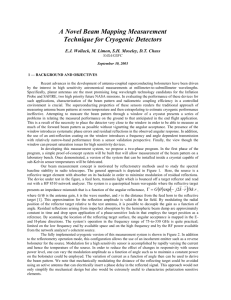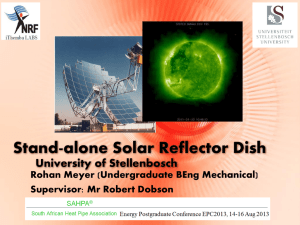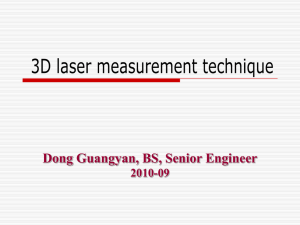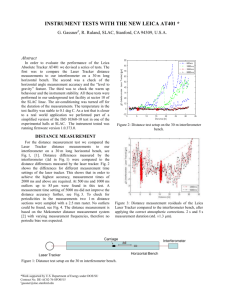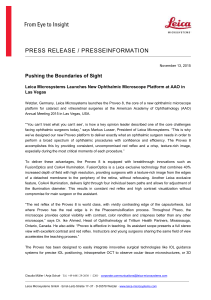TALK - SLAC
advertisement
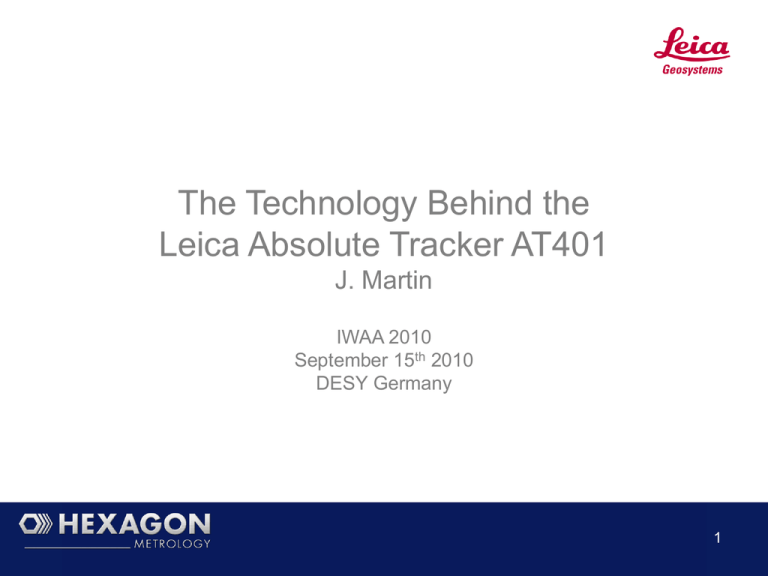
The Technology Behind the Leica Absolute Tracker AT401 J. Martin IWAA 2010 September 15th 2010 DESY Germany 1 Laser Trackers for Distance • Leica Geosystems Introduced the SMART310 20 years ago +/- 10µm per meter > 25m Micron level distancing (IFM) Limited by the Angular accuracy Limited portability 2 Total Stations for Angles • Almost 200 years of Theodolites and Total Stations Kern founded in 1891 History of 0.5 Arc Second accuracy Kern E2 Wild T2000 & 3000 Leica TDA5005 Leica TDRA6000 Battery operated for maximum portability 0.25mm distance (best case) 3 Three of the best sensors combined into one 4 Leica Absolute Tracker AT401 5 Absolute Angle Encoders Each encoder has an LED light source, mirrors for reflecting the emitted light, and a digital line sensor. The coded glass circle is based on radially aligned lines and is absolute and continuous. For the angle measurements, a light emitted by the LED is projected through the coded glass circle and onto the line sensor. This quadruple reading system is still capable of over 5000 readings per second. 6 Absolute Angle Encoders For a position determination, at least 10 code lines have to be captured by the line sensor. To increase the interpolation quality of the actual position, a minimum of 30 code lines are used for the signal processing. This gives a resolution of 0.07” and an absolute traceable accuracy of 0.5” 7 Precision Level to Gravity Sensor The inclination sensor mainly consists of an oil layer in a casing together with a prism that has an integrated line pattern, a digital line sensor, a light source and mirrors for reflecting the emitted light. The line pattern is projected on the line sensor after passing through the oil layer and being reflected twice by its surface. 8 Precision Level to Gravity Sensor The specific triangular line pattern allows the detection of both transverse and longitudinal inclination components by means of a one dimensional receiver. For transversal inclinations, the spacing between the diagonal lines is altered. For longitudinal inclinations, the center of the entire line pattern is shifted along the line sensor. Placing this sensor in the center of the alidade allows instant measurements after a rotation, which in turn, allows the compensator to be used to correct every measurement, not just a single gravity vector measurement. 9 Piezo Direct Drives Each drive consists of a pair of diametrically mounted Piezo-electric ceramics that accelerate and precisely position a ceramic cylindrical ring which is attached to the axis of the alidade. The nose moves in an elliptical pattern pushing against the ceramic ring at its tangent causing the mounted Piezo-electric ceramics to spin around the fixed ring. The direction and the speed of the elliptical movements are controlled by the particular active segment of the mounted Piezo-electric and the strength of the alternating voltage. 10 Leica Geosystems ADM The technology for the first ADM originally came from the Kern Mekometer which used a unique polarization modulation principal that was very insensitive to both long distances, and environmental influence. The three key parameters that influence the achievable accuracy of the polarization modulation principal also affect the shortest measurement distance. They are the modulation frequency, frequency bandwidth, and synthesizer (frequency) resolution. The smaller the frequency bandwidth the longer the minimum measurement distance, with the Mekometer requiring a minimum measurement distance of about 20 meters. 11 Leica Geosystems ADM Increasing these parameters is the equivalent of using a better scale to measure with; the higher the modulation frequency and the smaller the synthesizer resolution, the more accurate the achievable result is. To increase this even further the maximum modulation frequency of the Absolute Interferometer was increased to 2.4GHz providing a frequency bandwidth of 300MHz. This increase in frequency, in addition to an improved high speed synthesizer design which allowed for higher resolution of the frequency steps, gave the new design a typical accuracy over the full 80m range of about 5µm. 12 ATR & Laser Pointer In a standard laser tracker a Gaussian beam is used to determine the angular position to the reflector. The laser beam is emitted from the laser tracker and reflected back onto a Position Sensing Detector (PSD). The PSD is integrated into a control loop with the angle encoders and motors to keep the beam on the reflector as it moves. With a Gaussian beam the further away the reflector is from the narrowest point or “beam waist”, the less “focused” the beam is. As the beam becomes more divergent less light falls onto the reflector and less light is therefore returned to the PSD. X X 13 ATR & Laser Pointer An infrared beam is transmitted coaxially with the telescope line of sight towards a reflector that is in the Field of View (FOV). The beam is then reflected back creating an image on the CMOS chip. The angle between line of sight and line of object (angle #1) equals the angle between the line of sight and line of image (angle #2). These angles can be calculated from the known image pixel position on the CMOS array, the focal length and the size of the pixel. 14 ATR & Laser Pointer Coherent light sources, e.g. laser diodes, tend to have a nonhomogeneous light distribution characterized by “hot spots” or bright points within the beam. The AT401 on the other hand, uses a Superlumeniscent LED (SLED) as the ATR light source. Whereas a Laser Diode emits a narrow bandwidth, a superlumeniscent diode emits a broader spectrum of wavelengths, in the case of the AT401 ATR typically about 20nm (3dB). In order for a traditional laser tracker to lock-on to a reflector the reflector must be in line with the visible laser beam (+/- a couple of millimeters). With the ATR concept, the reflector only needs to be somewhere within the 0.6° FOV. @5m 15 OVC & PowerLock The PowerLock CMOS sits right next to the OVC CMOS in the telescope but has a completely separate design. The OVC is designed for live video and produces 30 frames per second of VGA quality video. The PowerLock module on the other hand uses slightly less resolution but a much higher frame rate of up to 200 frames per second. This ultra fast update rate allows the AT401 to track a moving reflector using just the PowerLock module. New FW changes give it the ability to distinguish between multiple reflectors that can be measured, as well as stray reflections in the work place. 16 Maximum Usability & Portability • • • • • • • • • • • A complete system weight of just 8kilo (including controller) Unique power options including both battery and PoE+ Use on lightweight tripods (even wooden survey tripods) Built in WiFi for completely cable-less operation 0.5 arc second (ISO 17123-3) encoders IP54 Dust and Water protection Integrated environmental monitor Typical working range of 160m +/- 10µm distance accuracy (MPE) Standard tracker feedback (3Hz) Multi-reflector enabled PowerLock 17 Questions ? 18

